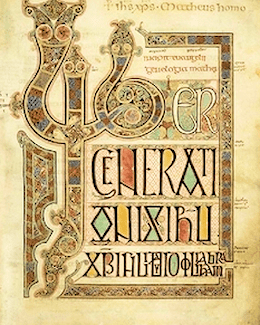Textus Receptus Bibles
Wessex Gospels c.1175
Anglo-Saxon
| 16:1 | Note: Homo quidam erat diues qui habebat uillicum & hic diffamatus est apud illum quasi dissipasset bona ipsius. Ða cwæð he to his leorning cnihten Sum welig man wæs. se hæfde sumne ge-refe. se warð wið hine forwreiged swilce he is god for-spilde. |
| 16:2 | Ða cleopede he hine & saide him. Hwi here ich þis be þe. agyf þine scyre. ne miht þu leng tun-scyre be-witen. |
| 16:3 | Ða cwæd se ge-refe. on his ge-þanke. Hwæt do ic for-þan þe min hlaford mine gerefscype fram me nymd. Ne maig ic delfen. me scamed þæt ic wædlie. |
| 16:4 | Ich wat hwæt ic do þæt hyo me on heore hus on-fon. þanne ic be-scyred beo fram tun-scyre. |
| 16:5 | Þa þa gafel-gyldo ge-gaderede wæren; þa saide he þam formen. hu michel scealt þu minen hlaforde. |
| 16:6 | þa saide he hund sestres eles. Þa saide he him. nym þine feðere & site raðe & writ fiftig. |
| 16:7 | Ða saide he oðren. hu mycel scelt þu. þa cwæð he. hund mittene hwætes. Ða cwæð he nym þine stafes & writ hund-ehtetig. |
| 16:8 | Ða herede se hlaford þare unrihtwisnesse tun-ge-refen. for-þam þe he gleawlice dede. For-þan þe þisse worulde bearn synde gleawre þissere leohtes bearnen on þisse cneornysse. |
| 16:9 | And ic segge eow wyrceð eow freond of þisse werold-weolen unrihtwisnesse. þæt hyo un-fon eow on echen earding-stowen þonne ge ge-teoriað. |
| 16:10 | Note: Qui fidelis est in minimo & in maiore fidelis est. Se þe is on litlen ge-treowe. se is on mare ge-treowe. Ænd se þe is on litlen unrihtwis. se is eac on maren unriht-wis. |
| 16:11 | Gyf ge on unrihtwisen weordwelan næren ge-treowe. hwa be-tæcð eow þæt eower is. |
| 16:12 | Ænd gyf ge on fremden næren ge-treowe. hwa syld eow þæt eower is. |
| 16:13 | Ne maig nan þeow twam hlaforden þewian. oððe he ænne hated. & oðerne lufeð. oððe he anen folgeð & oðer for-hugeð. & ge ne muge gode þewian & weorlde-welan. |
| 16:14 | --- |
| 16:15 | --- |
| 16:16 | --- |
| 16:17 | --- |
| 16:18 | --- |
| 16:19 | --- |
| 16:20 | --- |
| 16:21 | --- |
| 16:22 | --- |
| 16:23 | --- |
| 16:24 | --- |
| 16:25 | --- |
| 16:26 | --- |
| 16:27 | --- |
| 16:28 | --- |
| 16:29 | --- |
| 16:30 | --- |
| 16:31 | --- |

Wessex Gospels c.1175
The Wessex Gospels (also known as the West-Saxon Gospels) are a full translation of the four gospels of the Christian Bible into a West Saxon dialect of Old English. Designated Royal MS 1 A XIV, it is historically important.
- The Wessex Gospels are the oldest translations into English without the Latin.
- The gospels are written in the Old English West Anglo-Saxon dialect of Northumbria.
- Royal MS 1 A XIV is written on parchment and is also known as the Codex Evangeliorum Anglice.
- The title written at the top of the page, ‘Text[us] iv evangelior[um] anglice’, is reproduced in the 14th-century catalogue of the Benedictine Christ Church library, but at the Reformation this book was one of many acquired from religious houses by Thomas Cranmer, Archbishop of Canterbury from 1532 to 1534, whose name is written at the top of the page.
- Seven extant copies exist today. The earliest version dates from 990AD.
- Royal MS 1 A XIV was copied directly from MS 441 in the Bodleian library at Oxford. We know this as the same passages have been omitted from both. It has a transmission jump of 185 years.
- MS 441 (990AD) is extant and still resides in the Bodleian Library at Oxford University, England. It was given to the library by Baron Hatton in 1671. Paleographical evidence suggests a Canterbury origin. The earliest extant evidence of ownership is through Archbishop Matthew Parker (1504-75).
- MS Corp. Ch Coll Camb 140 (1000AD) is in Corpus Christi College Cambridge.
- Royal MS 1 A XIV (1175AD) is in the British Library and was presented to the British Museum by King George II in 1757 from the Old Royal Library.
- Royal MS 1 A XIV once belonged to the Prince of Wales: Henry Frederick, (1594-1612), eldest child of King James the First.
Why is this important?
- Desiderius Erasmus had access to these MSS before starting his translation of the Textus Receptus. In the five years prior to starting his translation work Erasmus was Professor of Divinity at Cambridge at a time when the university's benefactors owned these manuscripts.
- The King James Bible translators had access to these manuscripts. All the six KJV translation companies where housed at Oxford, Cambridge and Westminster and all had access to the Wessex Gospels.
- The codex contains the long ending in Mark chapter 16.
- The codex contains the Pericope Adulterae (John 7:53-8:11)